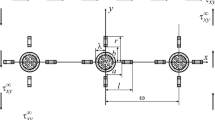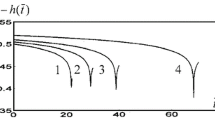Abstract
A discrete model of springs with bond-bending forces is proposed to simulate the fracture process in a composite of short stiff fibers in a softer matrix. Both components are assumed to be linear elastic up to failure. We find that the critical fiber length of a single fiber composite increases roughly linearly with the ratio of the fiber elastic modulus to matrix modulus. The finite size of the lattice in the direction perpendicular to the fiber orientation considerably alters the behavior of the critical length for large values of the modulus ratio. The simulations of the fracture process reveal different fracture behavior as a function of the fiber content and length. We calculate the Young’s modulus, fracture stress, and the strain at maximum stress as a function of the fiber volume fraction and aspect ratio. The results are compared with the predictions of other theoretical studies and experiments.
Similar content being viewed by others
References
D. Hull, An Introduction to Composite Materials (Cambridge University Press, Cambridge, 1981).
P. M. Duxbury, in Statistical Models for the Fracture of Disordered Media, edited by H. J. Herrmann and S. Roux (North-Holland, Amsterdam, 1990), p. 189.
Y. Termonia, J. Mater. Sci. 22, 504 (1987).
Y. Termonia, J. Mater. Sci. 22, 1733 (1987).
Y. Termonia, J. Mater. Sci. 25, 4644 (1990).
For a recent review, see Statistical Models for the Fracture of Disordered Media, edited by H. J. Herrmann and S. Roux (North-Holland, Amsterdam, 1990).
P. D. Beale and D. J. Srolovitz, Phys. Rev. B 37, 5500 (1988).
W.A. Curtin and H. Scher, J. Mater. Res. 5, 535 (1990).
S. Roux and E. Guyon, J. Phys. Lett. (Paris) 46, L999 (1985).
H. J. Herrmann, A. Hansen, and S. Roux, Phys. Rev. B 39, 637 (1989).
S. Sahu and L.J. Broutman, Polym. Engin. Sci. 12, 91 (1972).
A.N. Gent and C. Wang, J. Mater. Sci. 27, 2539 (1992).
H. Kleinert, Gauge Fields in Condensed Matter (World Scientific, Singapore, 1989), Vol. 2, p. 768.
S. Feng and P.N. Sen, Phys. Rev. Lett. 52, 216 (1984).
M.A. Lemieux, P. Breton, and A-M.S. Trembley, J. Phys. Lett. (Paris) 46, LI (1985).
L. de Arcangelis, A. Hansen, H. J. Herrmann, and S. Roux, Phys. Rev. B 40, 877 (1989).
Y. Kantor and I. Webman, Phys. Rev. Lett. 52, 1891 (1984).
S. Arbabi and M. Sahimi, Phys. Rev. B 38, 7173 (1988).
E. Louis, F. Guinea, and F. Flores, in Fractals in Physics, edited by L. Pietronero and E. Tossatti (Elsevier, Amsterdam, 1986).
S. Roux, in Ref. 6, p. 87.
This kind of external displacement, with free boundary conditions on the lattice edges, leads to an enhanced strain on the bonds that are in the corners of the lattice. In fact, for a homogeneous lattice, the most strained bonds are the horizontal bonds on the extreme right and left of the rows next to the top and the bottom ones. These have elongations about 20% higher than those of the interior bonds. This strain enhancement leads to fracture initiation from those bonds in pure matrix materials, or in materials with low concentration of fibers. The same effect was noticed in the study by Curtin and Scher.8 It is probably possible to correct this drawback by using a more complex geometry for the lattice so as to render the stress distribution more uniform. However, we think that although the simulated fracture stresses in this geometry turn out to be smaller than what they should be, the qualitative results are not affected.
J. Stoer and R. Bulirsch, Introduction to Numerical Analysis (Springer-Verlag, New York, 1980), p. 572.
G. G. Batrouni and A. Hansen, J. Stat. Phys. 52, 747 (1988).
This is another aspect in which this model differs from the work of Herrmann et al.10 They included all the intermediate displacements in their stress-strain curves, using some averaging process. It is not clear to which physical assumptions their averaging corresponds.
H. L. Cox, Br. J. Appl. Phys. 3, 72 (1952).
E. M. Asloun, M. Nardin, and J. Schultz, J. Mater. Sci. 24, 1835 (1989).
A. Kelly and W. R. Tyson, J. Mech. Phys. Solids 13, 329 (1965).
M.J. Folkes and D.A.M. Russel, Polymer 21, 1252 (1980).
W. Weibull, Fatigue Testing and Analysis of Results (Pergamon, New York, 1961).
L. Monette, M. P. Anderson, S. Ling, and G. S. Grest, J. Mater. Sci. 27, 4393 (1992).
Author information
Authors and Affiliations
Rights and permissions
About this article
Cite this article
Murat, M., Anholt, M. & Wagner, H.D. Fracture behavior of short-fiber reinforced materials. Journal of Materials Research 7, 3120–3131 (1992). https://doi.org/10.1557/JMR.1992.3120
Received:
Accepted:
Published:
Issue Date:
DOI: https://doi.org/10.1557/JMR.1992.3120




